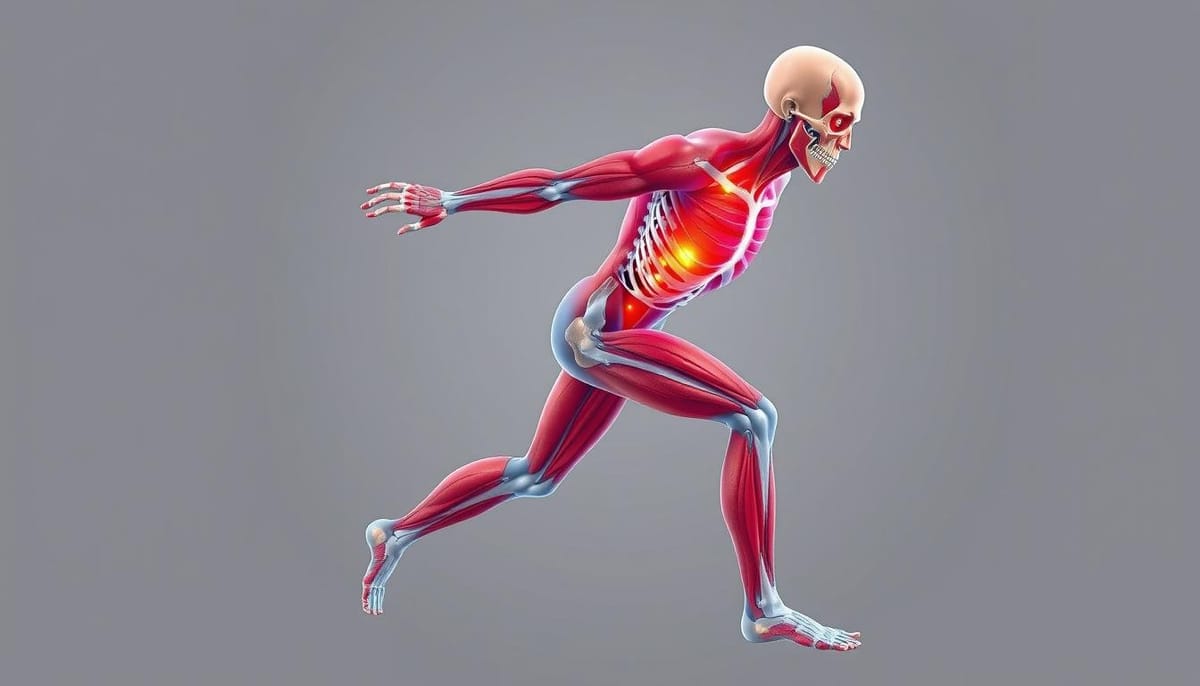Tore: Understanding Muscle Strains and Injuries
Discover the causes, symptoms, and treatments for muscle tears. Learn how to prevent and manage these common injuries for a quicker recovery and return to activity.

Muscle strains are common, especially among athletes and active people. They happen when muscles stretch too far and tear. These injuries can be mild or severe, affecting tendons too.
These injuries are frequent, especially in athletes. Symptoms include pain, swelling, and weakness. They can be graded from mild to severe, with the worst needing surgery.
Knowing what causes muscle strains helps prevent them. Activities like contact sports and throwing motions raise the risk. Employers must also address work-related risks to prevent injuries.
Preventing muscle strains means stretching and strengthening regularly. If you feel sudden pain, see a doctor. It might be a serious injury needing treatment.
By understanding muscle strains, we can prevent and manage them better. This is important for everyone and employers.
What is a Muscle Strain?
A muscle strain is when you hurt a muscle or its tendons. It's common and can happen from too much use or not using it right. You might feel it in your lower back, neck, shoulder, or hamstring.
Muscle Strain vs. Pulled Muscle
There's no real difference between a strained muscle and a pulled muscle. Both mean you've hurt the muscle fibers. They're just different ways to say the same thing.
Muscle Strains vs. Hernias
Muscle strains and hernias both come from too much use. But they're not the same thing. A muscle strain is a tear in the muscle, while a hernia is when something inside breaks through the muscle wall. You can usually treat muscle strains at home, but hernias need surgery.
| Condition | Description | Treatment |
|---|---|---|
| Muscle Strain | Tear or damage within muscle fibers | Rest, ice, compression, elevation, anti-inflammatory medication, light stretching |
| Hernia | Internal organ or tissue breaks through muscle wall | Surgical repair |
Muscle strains can be mild or severe. How long it takes to heal depends on the injury. A small sprain might heal in 10 days, but a bad strain could take weeks.
Symptoms of a Tore Muscle
When you suffer a muscle strain, you may feel a lot of pain. Muscle strain symptoms include pain, swelling, and bruising. You might also see redness, muscle spasms, weakness, and find it hard to use the muscle.
The severity of these muscle tear symptoms depends on the grade of the strain. This means how bad the injury is.
Grades of Muscle Strains
Muscle strains are divided into three grades. This helps doctors understand how serious the injury is:
- Grade 1 strains are mild, with minimal impact on strength and motion.
- Grade 2 strains are more serious, with partial tearing of the muscle fibers.
- Grade 3 strains involve a complete tear of the muscle or tendon, resulting in significant pain, swelling, and loss of function.
Knowing the grades of muscle strains is key for proper diagnosis and treatment. If you have a severe muscle strain, it's important to see a doctor. This ensures you get the right care and avoid more problems.
Causes and Risk Factors
Muscle strains can happen for many reasons. Acute muscle strains often result from sudden, forceful actions. This can be lifting something heavy with bad form or quick, explosive movements in sports.
On the other hand, muscle strains can also come from doing the same thing over and over again. This is called repetitive motion or overuse.
There are certain things that make it more likely to get a muscle strain. These include:
- Playing sports that involve quick changes in direction and speed, like football, basketball, or soccer
- Working jobs that are very physically demanding, such as construction, manual labor, or healthcare roles that require heavy lifting
- Having muscles that are tight or weak, which can make it harder to move and be stable
- Not warming up properly before starting to be active
Age can also play a role, as muscles tend to get less flexible and strong as we get older. Obesity is another risk factor, as extra weight can put more stress on muscles and joints.
| Risk Factor | Description |
|---|---|
| Contact Sports | Activities that involve sudden changes in direction and speed, like football, basketball, or soccer |
| Physically Demanding Occupations | Jobs that require heavy lifting, such as construction, manual labor, or healthcare roles |
| Tight or Weak Muscles | Reduced flexibility and stability can increase the risk of muscle strains |
| Lack of Warm-up | Failing to properly prepare the muscles before physical activity |
| Age | Muscle flexibility and strength tend to decline with advancing years |
| Obesity | Excess weight can place additional stress on the muscles and joints |
https://www.youtube.com/watch?v=IM7BIO_kdk8
Knowing the causes of muscle strains and risk factors helps us prevent injuries. It also helps us keep our muscles healthy.
Prevention Tips
Being proactive and taking preventive steps can help avoid muscle strains. Regular stretching and conditioning exercises are key. They keep muscles flexible and strong, making them less likely to get strained.
Stretching and Conditioning
Adding a good stretching for muscle strains routine to your workout can lower injury risk. Focus on stretching the muscles you use most. Gentle, dynamic stretches before and after workouts help prepare and cool down your muscles.
Strength training is also vital for preventing muscle strains. Exercises like squats, lunges, and core-strengthening moves build muscle endurance. This helps your muscles support your movements and withstand strain.
Ergonomics at Work
Good ergonomics for muscle strain prevention at work can also help. Make sure your workstation is set up right. Take breaks to stretch and move around. Varying your tasks can also reduce muscle strain.
| Prevention Strategies | Benefits |
|---|---|
| Regular Stretching | Improves flexibility and reduces muscle tension |
| Strength Training | Builds muscle endurance and stability |
| Proper Ergonomics | Minimizes workplace strain and overuse |
By adding these preventive steps to your life, you can lower your risk of muscle strains. Your body will be better prepared for daily activities and sports.
Treatment and Management
When treating muscle strains, the first step is the RICE method - rest, ice, compression, and elevation. This method helps lessen pain and swelling. It also prevents further injury. Anti-inflammatory drugs from the pharmacy can also help with healing.
First Aid for Muscle Strains
For minor muscle strains, simple first aid is usually enough. The RICE protocol is the best approach:
- Rest: Stay away from activities that hurt the muscle. This lets it heal.
- Ice: Use ice packs on the area for 15-20 minutes, several times a day. It reduces swelling and pain.
- Compression: Use an elastic bandage to support the muscle and limit swelling.
- Elevation: Elevate the injured limb above heart level. This helps drain fluid and reduce swelling.
Medical Treatment Options
If the strain is severe or doesn't get better in 24-48 hours, see a doctor. They might suggest:
- Physical therapy to improve strength and flexibility
- Bracing or immobilization to support the muscle while it heals
- Surgery for severe muscle tears
Getting medical help quickly is important. Ignoring a muscle strain can cause long-term pain and weakness. A good treatment plan helps you recover faster and get back to your activities.
Conclusion
Muscle strains are common in active people or athletes. Knowing about different types, causes, and how to prevent and treat them helps a lot. Regular stretching and conditioning exercises can lower the risk of muscle strains.
When muscle strains happen, quick first aid and proper medical care are key for fast recovery. Whether it's a minor or severe strain, following the right steps helps avoid more damage. This way, you can get back to your favorite activities without worry.
To keep an active lifestyle, understanding muscle strains is crucial. Taking steps to prevent them and getting medical help when needed helps a lot. This way, you can keep doing what you love, without muscle strains holding you back.




